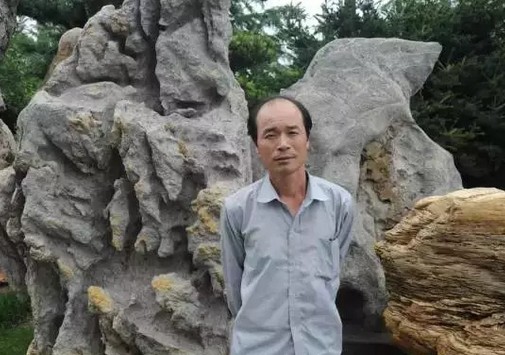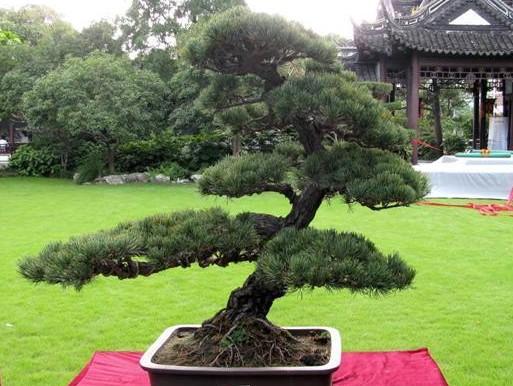The artistic Features of Shanghai-style Bonsai
Although Shanghai-style bonsai was developed and formed after the founding of the people's Republic of China, it also has a historical tradition. As early as the Ming Dynasty, there was a man named Zhu Sansong in Shanghai who chose flowers and trees to cut them. Although they were not tall, Qixiu Canggu had the potential of a hundred feet of Qiu long. There are some bonsai experts and bonsai lovers in Shanghai who carefully studied the bonsai art as early as the 1930s.

In recent years, Shanghai-style bonsai has made a new breakthrough in the composition of Yun Si, focusing on the description of artistic conception. Such as the performance of distant mountains, stone does not plant trees, only plant Scutellaria barbata and other grass, and spread with green moss, pay attention to Qingtian stone carved pavilions, Zhouqiao and other small embellishment, basin Zhongshan stone slope gentle bank bend, vast water surface, appears to be high in the sky, misty waves vast, showing "spring breeze and green Jiangnan bank" artistic conception.
The artistic features of Shanghai-style bonsai are mainly as follows:
First, learn from nature and enter the painting in ancient times. Bonsai comes from nature, but it is not the displacement and reproduction of natural scenery, but according to the principle of nature and the conception of image meaning, bonsai is sublimated from natural state to artistic form through meticulous design and processing, such as beautiful mountains, Lishui, hills, trees, strange flowers, strange grass and so on. All kinds of Shanghai-style bonsai works are works of art that conform to nature and are higher than nature. Among them, the pile scene is mainly evergreen pine and cypress, with more than 140 kinds of wood. The pile scene is processed and modeled with wire and other tools, and the basic technique is "fine binding and fine cutting, the bending of the trunk and main branches, mostly showing a smooth" curve ", curved and extended freely, and the lateral branches are mostly rigid" broken lines ". There are strong and soft, strong and soft.
The whole pile scene of the tree potential, there seems to be no artificial traces, appears simple and vigorous, tall and straight meaningful show. For example, many piles in the bonsai garden of the Shanghai Botanical Garden, which are more than a hundred years old, are rare art treasures. They enjoy a high reputation at home and abroad. According to the geological structure of different rocks, using different binding methods to process, the texture is delicate and natural and perfect. Miniature bonsai also let nature take its course, small in the big, amazing workmanship, very popular with people.
Second, the layout is reasonable and rich in variety. The natural landscape is ever-changing, but regular. In order to show the elegant demeanor of nature and enhance the aesthetic effect, a reasonable layout is very important. The layout of pirated scenery in Shanghai places great emphasis on theme, hierarchy and variability, avoiding the "layout congestion" pointed out in the Twelve taboos of painting, which is pointed out in the Twelve taboos of painting, such as "layout congestion; regardless of distance, mountain without pulse; water without source flow; environment without danger; stone stop side; trees lack four branches" and other disadvantages, uneven height and height of the mountain, twists and turns of shore time. The steepness of the slope, the narrowness of the water surface, and the natural charm of emptiness and reality, far and near, movement and stillness are all shown incisively and vividly.
In particular, the landscape bonsai has a particularly exquisite layout and composition, which absorbs the "scattered perspective" method of Chinese painting; the potted landscape materials and furnishings are scattered in the basin, the lying peak is winding, and the vertical peak competes for height. The distant view is majestic, and the near appreciation texture is clear, which is really "hundreds of miles of mountains, all in a small basin". In particular, it is mentioned that this method of layout creation was not formed at once, and Shanghai played an important role in the reform and development of landscape bonsai. In the past, hard stone was often used as a stone for appreciation, and water-absorbing pine stone was often placed in a deep basin, only looking at the posture of its peaks, but not the foothills.
Since the 1960s, bonsai masters such as Dong Shuyu and Yin Zimin have made bold innovations in landscape bonsai, taking the lead in using shallow bauxite basins or marble basins, not only to see the hillsides of their peaks, "but also to appreciate the foot of the slope and the scenery of the mountains when they are tortuous and changeable. At the same time, it also changed the old habit of tedious and colorful furnishings in the past, and actively selected axe-split stone, stalagmite, quartz stone, Xuancheng stone and other rich hard stone as bonsai, and planted grass on the stone.
Third, naming is relevant, profound meaning, bonsai naming, and the description of nature, such as poetry, painting, reflects the author's understanding and feelings of "natural beauty". The appropriate refinement and proper expression of the profound theme of decanting can deepen our conception of the theme of bonsai and its imaginative power.
Shanghai-style landscape bonsai are mainly close-up, with towering mountains in the basin, dense trees and green trees, and the momentum of "the peak seat is connected less than a foot from the sky." Shanghai-style "palmtop bonsai" is exquisite and exquisite, but in a basin the size of a wine cup or even a seal, the branches are luxuriant and the good fruit is full of branches. Although it is so small that it can be placed on the palm, it still has the state of wild ancient trees. This is another feature of Shanghai bonsai. Recently, Shanghai-style bonsai has won many awards in horticultural exhibitions in Canada, the Netherlands, Yugoslavia, Denmark and other countries, and has sent staff to the United States to teach bonsai production skills.
Time: 2019-06-04 Click:
- Prev

Wang Miaoqing, a master of bonsai of Shanghai School, and his "One Pot Garden"
He had passed by the entrance of this garden several times and thought it was just an ordinary workshop for making stone carvings and planting trees, so he had not studied it carefully. Once again came here, step into it, found that although the garden is not big, but there is a hole. All kinds of Taihu stones of different shapes are placed at random
- Next

Representative Tree Species and Artistic Style of Shanghai Style Bonsai
Shanghai style bonsai is one of the excellent traditional arts of Han nationality, which is a bonsai art school named after Shanghai. It contains literature and aesthetics, and integrates plant cultivation, plant morphology, plant physiology, garden art and plant modeling art. The distribution range of Haipai bonsai is mainly in Shanghai and its surrounding counties and cities
Related
- Fuxing push coffee new agricultural production and marketing class: lack of small-scale processing plants
- Jujube rice field leisure farm deep ploughing Yilan for five years to create a space for organic food and play
- Nongyu Farm-A trial of organic papaya for brave women with advanced technology
- Four points for attention in the prevention and control of diseases and insect pests of edible fungi
- How to add nutrient solution to Edible Fungi
- Is there any good way to control edible fungus mites?
- Open Inoculation Technology of Edible Fungi
- Is there any clever way to use fertilizer for edible fungus in winter?
- What agents are used to kill the pathogens of edible fungi in the mushroom shed?
- Rapid drying of Edible Fungi

